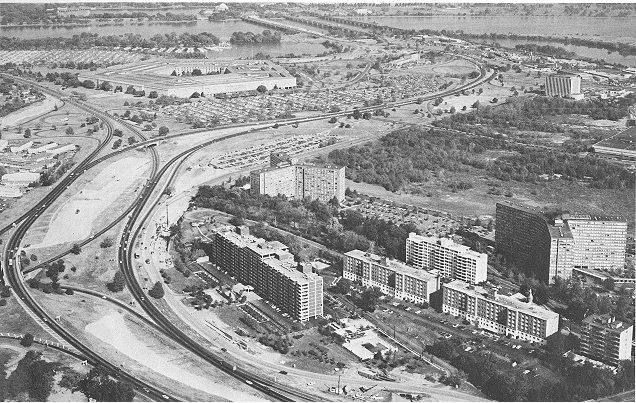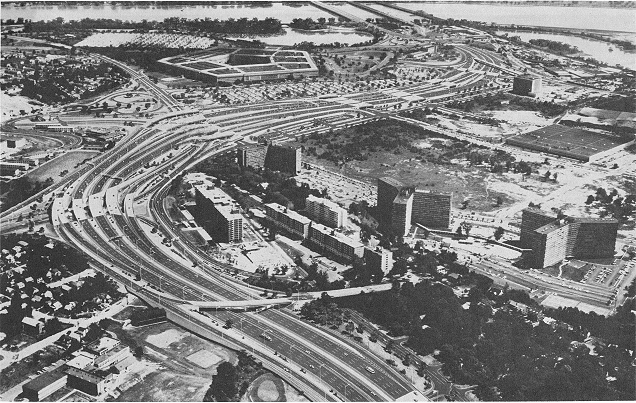

THE HISTORY AND HERITAGE OF
CIVIL ENGINEERING IN
VIRGINIA
The Mixing Bowl Project (1970-1973)
"The most complex, challenging project ever undertaken in the history of the Virginia Department of Highways", is the characterization by Douglas B. Fugate, State Highway Commissioner, when speaking of that portion of the Shirley Highway, or of Interstate-95, beginning just south of the Pentagon then curving around that military installation and then connecting to Columbia Pike, U.S. Route 1, the George Washington Memorial Parkway and serving four of the arteries into the Pentagon. This eighth, of a nine-part Shirley Highway modernization, is proceeding to completion in 1973 and 1974 while maintaining the normal flow in excess of 100,000 vehicles per day, a miracle in traffic service and control, which include some 30,000 vehicles into the Pentagon itself. The three-grade levels beginning at the first of these entrances eliminates the increasing difficulties of the former single-grade mixing of through cross traffic as it seeks to reach Arlington Memorial and the 14th Street Bridges, thus the "Unscrambling of the Mixing Bowl".
The essentials of this design and construction is to provide safer and more rapid transit over the northern seventeen miles of Interstate-95, the Shirley Highway. The four-lane cross State I-95 expands to 10 lanes on approach to the metropolitan area, continuing as far as the Washington Boulevard, the first entry to the Pentagon, where it enlarges to 28 lanes and the three grade-levels stated. Another unique feature of this modernization is the reservation of the central two lanes as busways for rapid bus movement, the first of such vehicular priorities in the nation. Some five and a half miles of a completed section of this road had been used in this experimental way since 1969, and had been found that bus traffic had increased by 20 to 30 per cent the first year. This mode of mass conveyance will be continued through the remainder the Shirley Highway and into the District. It will be reversible in direction to accommodate passenger traffic demand and to speed the flow. Busways are being incorporated in highways elsewhere since this use.
Historically the original Shirley Highway was Virginia Route 350, before the establishment of the interstate system. Upon the construction of I-95 the name of Shirley Highway was transferred to the northern seventeen miles if it, honoring in this way Henry G. Shirley, Virginia State Highway Commissioner for 19 years, prior to his death in 1941. It was during Mr. Shirley's tenure that the main north-south highway, U.S. Route 1, was paved through the State. At the time of construction the Shirley Highway embodied elements of the highest type of road: two concrete ribbons, each 24 feet wide, separated by a grass median varying from 14 to 70 feet of width; gentle horizontal curves limited to slightly more than one degree and located to minimize headlight glare from on-coming vehicles; and maximum ascending grades of 3.5 per cent, and descending, to 4.2 per cent.
The term "Mixing Bowl" was applied shortly after that part of Shirley Highway north of Virginia Route 7 was constructed as part of the Pentagon road network in the Federal Government's program there in 1942. Traffic forecast at that time was 30,000 vehicles per day, and with a Pentagon population of about 30,000. The Federal Government turned over its responsibility for this section of road to the Virginia Department of Highways in 1963, when the latter began reconstruction on the south end of the Virginia portion of the road as a result of studies of traffic problems begun in 1960. Rebuilding from King Street, in Alexandria to just south of the "Mixing Bowl" cost approximately $25,100,000. The "Unscrambling of the Mixing Bowl" was bid in June 22, 1970, at $51,599,791 on offer from combination of five contractors. The only other offer exceeded $53,000,000.
Major elements involved in this construction included the very difficult task of maintaining daily traffic in excess of 100,000 vehicles, holding it within the right of way limitations as no suitable substitute routes were available for detouring; the shifting of busways from place to place in order to maintain this very beneficial service until it could be permanently located in the center of the lanes of travel; the inclusion of four temporary bridges, one of which was one of 570 feet to assist busway construction; and construction of a 200-foot tunnel, 14.5 feet in diameter, to take Long Branch Creek for drainage under the highway. Temporary paving provided a shift from the original, construction of the new lane, releasing traffic to the new lanes, opening detours further along the way, all was the sequence of construction. Utilities such as telephone, electricity, gas, water and sewerage were continued without interruption as were the cold water and steam lines for the Pentagon services. Estimates of materials and work involved were 583,000 cubic yards of excavation and 577,000 cubic yards of borrow, aggregating some 1,500,000 cubic yards of earth removal; 67,900 cubic yards of concrete; 17,334,000 pounds of structural and reinforcing steel; 13.6 miles of underdrains; 21 miles of curbs; and 56,000 feet of guardrail. Extension of I-95 to U.S. Route 1 include 19 more bridges as well as improvements in the latter road at the connection. Traffic expected through this segment of Shirley Highway is estimated to be about 147,000 vehicles per day.
Local ecology was an important consideration in design and construction. Dredging and filling were studied carefully and a sandy fill material over ramps was used to control silt removal in erosion, and, as a factor of safety, desilting basins have been included to protect surface streams. Smoother paving as well as the grade separations were to eliminate stop-and-start of traffic but to permit uninterruption of movement, save on fuel and to appreciably reduce emissions in exhausts both of passenger and truck as well as bus vehicles.
The appearance and beautification of its highways has been of concern to the Department of Highways and it maintains a section devoted to this in its design division. However, for the projects along the Shirley Highway Messrs. Stanley Abbott and Edward G. Carson and Associates, of Williamsburg and Norfolk respectively, were consultants who designed and directed landscaping from Woodbridge to Duke Street (the Little River Turnpike, or Virginia Route 236), a distance of 13.6 miles on which were planted some 30,000 rose bushes, 1,500 dogwoods, 25,000 pines, ivy, holly and seventy five varieties of trees and shrubs aggregating about 185,000 trees and shrubs, some as tall as ten feet. This was one of the most ambitious beautification projects undertaken by the Department. Landscaping appropriate to the surroundings, available median and side space in right of way exposure will be extended northward to the Potomac as paving and grading is completed.
The location of this modernization of a highway with its improvement in construction, continuity of traffic flow, uniqueness of busways, all involved several governments and their agencies, other than the Virginia Department of Highways: the Federal Highway Administration, the Pentagon, the Army Corps of Engineers, General Services Administration, the National Park Service, the District of Columbia Highway Department, Washington Metropolitan Area Transit Authority, Washington Aqueduct, and Arlington County were interested and contributed to the final result.
Total cost of rebuilding and modernizing the Shirley Highway is estimated at $164,000,000.
Sources of Information:
Federal Bureau of Public Roads
Virginia Department of Highways
U.S. Army Corps of Engineers


|
Click photo for full size photo.
[Top of Page]
[Table of Contents]
Return to Virginia Section Home Page
This page was last revised September 25, 1998. Please send your comments to the Virginia Section Newsletter Editor / Webmaster.